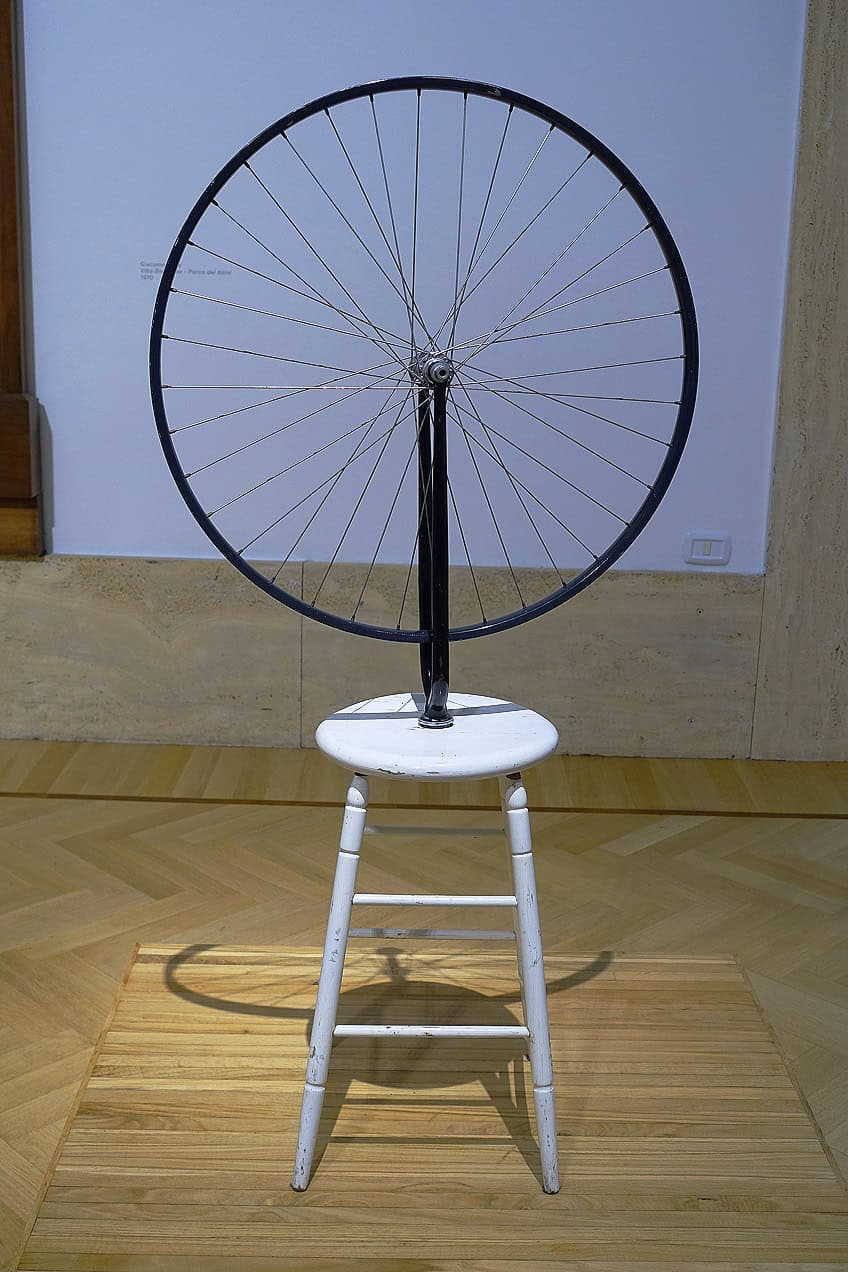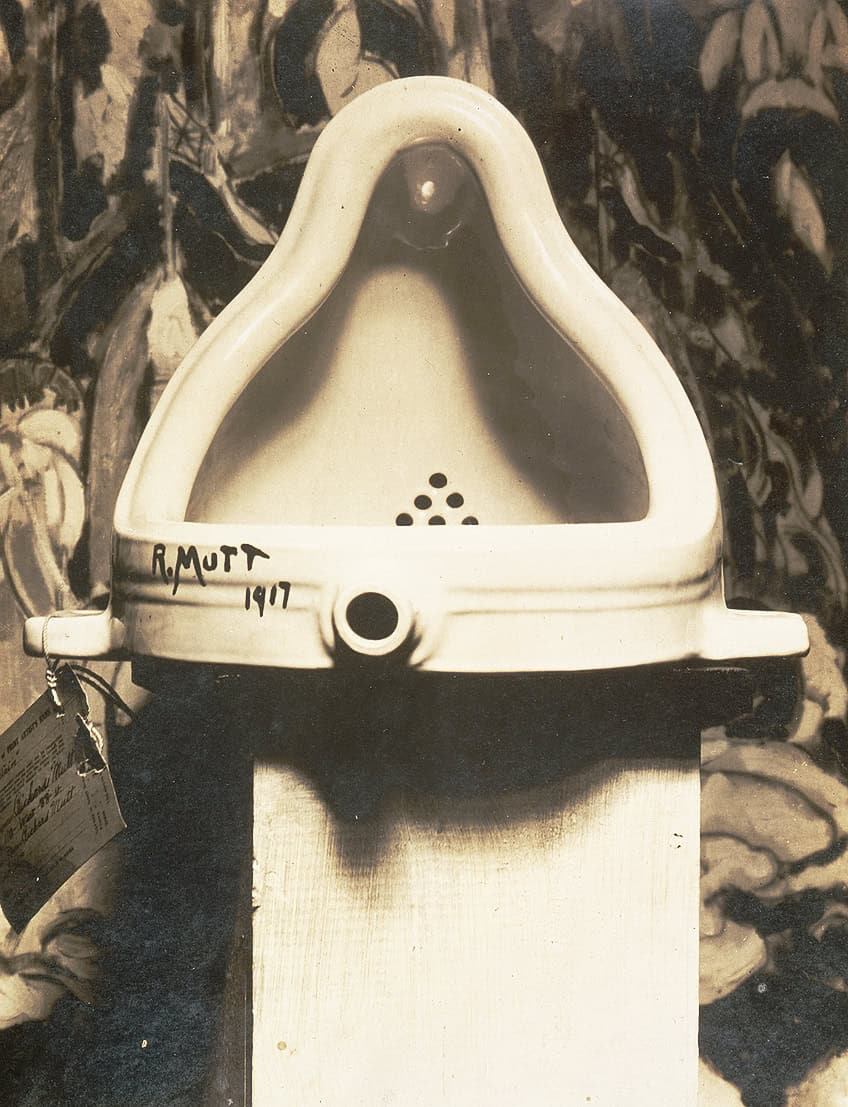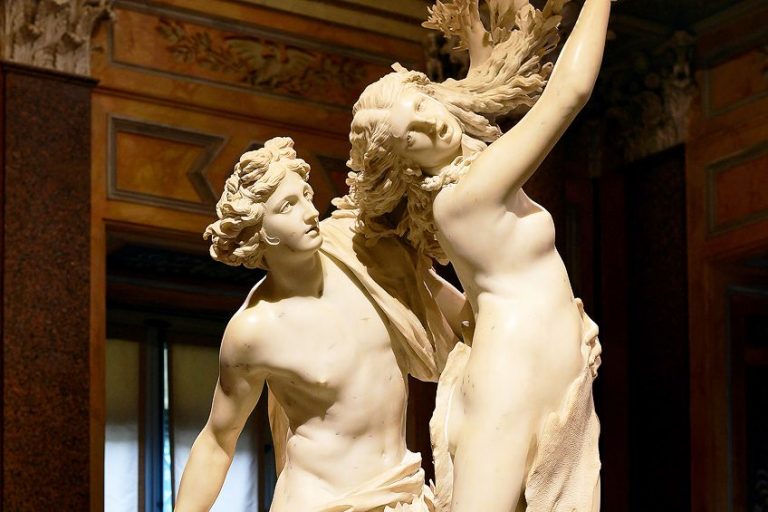“Bicycle Wheel” by Marcel Duchamp – The Wheel of Innovation
Marcel Duchamp’s Bicycle Wheel is a groundbreaking work that challenges traditional notions of art and perception. Created in 1913, this iconic piece marks Duchamp’s exploration into the realm of readymades, ordinary objects elevated to the status of art through context and presentation. Bicycle Wheel consists of a bicycle wheel mounted on a stool, inviting viewers to reconsider the boundaries of artistic expression and the role of the artist. Duchamp’s innovative approach continues to influence contemporary art, sparking conversations about the nature of creativity and the concept of art itself.
Table of Contents
Key Takeaways
- Bicycle Wheel is Marcel Duchamp’s first Readymade, created in 1913, and is a seminal work in modern art.
- The piece redefined the concept of art, introducing the use of ordinary objects as artistic works.
- Its significance persists today, influencing contemporary art and the understanding of artistic authorship.
Who Was Marcel Duchamp?
| Birth | July 28, 1887 |
| Death | October 2, 1968 |
| Place of Birth | Blainville-Crevon, France |
| Genre of Work | Dadaism, Surrealism, and Conceptual art |
Marcel Duchamp was a French-American artist, born on July 28, 1887, in Blainville-Crevon, France. Known for challenging the conventions of art, Duchamp’s work is associated with Dadaism and conceptual art, movements that emerged as a reaction to World War I and emphasized irony, wit, and the questioning of established norms. Duchamp moved to the United States in 1915, where he became a part of the New York art scene. His daring approach to art extended to his personality as well, often being described as enigmatic and intellectual.

Key Contributions
- Readymades: Objects found or purchased and presented as art with minor alterations.
- Conceptual art: Art where the idea is more important than the craft.
- Dada movement: An art movement characterized by a disdain for cultural and artistic conformity.
Notable Works
Duchamp’s influence extends beyond visual art to affect philosophy and social attitudes towards art itself. He believed that the viewer’s interpretation completes the artwork, thus pioneering the participatory role of the audience in art. Some of his most notable works include Nude Descending a Staircase, No. 2 (1912), Bicycle Wheel (1913), and Fountain (1917). His work continues to inspire and provoke debates in the art world, cementing his legacy as a pivotal figure in 20th-century art.
Duchamp passed away on October 2, 1968, in Neuilly-sur-Seine, France, but his impact remains relevant today.
The Genesis of Bicycle Wheel
| Date | 1913 (original version); replicas made later |
| Medium | Bicycle wheel mounted on a painted wood stool |
| Dimensions (cm) | Approx. 131.1 x 63.5 x 31.8 |
| Where Is It Housed? | Various collections; original version lost, replicas in museums such as the Museum of Modern Art, New York City, United States |
Marcel Duchamp’s Bicycle Wheel is heralded as the progenitor of the Readymade, an innovative art form where the artist uses everyday objects devoid of aesthetic appeal and repositions them as art. Created in 1913, Bicycle Wheel simply consists of a metal bicycle wheel mounted atop a wooden stool. Rather than sculpt or paint, Duchamp challenged artistic norms by selecting and designating an ordinary object as artwork, thus opening a dialogue on the very nature of art.

The work, while seemingly straightforward in its composition, ignited a significant shift in the perception of artistic creativity and the role of the artist. Duchamp’s Bicycle Wheel was not about crafting something new but rather reframing something that already existed. This act of recontextualization was rebellious for its time, defying the expectation that art must result from laborious, skilled craftsmanship.
Over time, Duchamp replicated Bicycle Wheel several times, emphasizing the idea’s precedence over the tangible artifact.
Historical Context
In the early 20th century, Paris was the epicenter for avant-garde artists. Duchamp, existing in this milieu, conceived Bicycle Wheel in a period ripe with artistic experimentation. It was an era that challenged traditional art forms and sought to redefine the boundaries of what could be considered art.
Duchamp’s Vision
Duchamp selected everyday objects with a sense of visual indifference, free from the constraints of good or bad taste. Bicycle Wheel exemplified this through its simplistic composition: a wheel mounted on a stool. It was not only a piece but also an event, encouraging viewers to see mundane objects as potential art.
The Influence of Dadaism
The Dada movement, emerging during World War I as a response to the absurdity of the conflict, influenced artists to embrace randomness and reject conventions. Duchamp’s work paralleled the anti-art stance of Dada, even though the movement itself would only crystalize years after Bicycle Wheel was first created.
Readymades in Art
Duchamp pioneered the concept of the readymade—prefabricated objects designated as art. These objects were often chosen for their utilitarian qualities and presented without intervention. Bicycle Wheel is the inaugural example of a readymade, wherein Duchamp redefined the object’s purpose.

First Presentation
The original presentation of Bicycle Wheel is thought to have been in Duchamp’s studio, although the original piece from 1913 was lost. Its significance persisted, and a 1951 replica was made, establishing its position in the art world permanently, and solidifying Duchamp’s legacy as a forebear of conceptual art.
This version resides in New York, underscoring the artist’s transatlantic impact.
Bicycle Wheel’s Impact on Art
Marcel Duchamp’s Bicycle Wheel is a pioneering piece that dramatically shifted perceptions of what constitutes art. It serves as an emblematic invention of the readymade concept, influencing subsequent modern art movements and artistic freedoms.

Redefining Readymades
Bicycle Wheel is hailed for its innovative approach to art. Duchamp’s choice of everyday objects for his art, by attaching a bicycle wheel to a stool, reframed these objects as art when placed in a new context. The piece challenged traditional craftsmanship and aesthetics, pushing the boundaries of art to include mass-produced items.
This act, which seemed mundane at the time, revolutionized the art world by introducing the idea that the selection process itself could be a creative act.
Museum of Modern Art has the work as an example of Duchamp’s broader impact. The Readymades are now fundamental to understanding the evolving boundaries of artistic creation and are exhibited to reflect this historical significance.
Influence on Modern Art
Duchamp’s work catalyzed a paradigm shift, affecting how contemporaries and future generations conceived of and interacted with art. Bicycle Wheel indirectly laid the groundwork for a wide variety of later art movements. Cubism, Dada, and Surrealism, amongst others, owe a debt to the intellectual challenges Duchamp’s work introduced, as they all endorse a departure from conventional art forms, often featuring ordinary objects placed in extraordinary arrangements.

Moreover, his work’s impact persisted well into the latter half of the 20th century, reverberating in Pop Art and Conceptual Art—movements that further explored the readymade concept and its implications for the production and consumption of art.
Artistic Movements and Legal Rights
Duchamp’s Bicycle Wheel also paved the way for discussions about artists’ rights and the ownership of creative concepts. Organizations like the Artists Rights Society (ARS) and ADAGP represent the intellectual property interests of artists, ensuring recognition and fair practice in the reproduction and dissemination of their works.
The legacy of Duchamp’s concept reoriented the ways in which art is monetized and protected, providing a legal framework that supports artists in a way that diverges from traditional copyright but is still crucial for the recognition and economic rights of creators.
As the provocateur of a newfound artistic language, Duchamp empowered artists to explore the multi-faceted nature of art and its intersection with legal and societal frameworks, crafting a narrative that is as much about intellectual property as it is about aesthetic innovation.
Physical Composition and Replications
Marcel Duchamp’s Bicycle Wheel is a pioneering work that merged everyday objects into the realm of art. Its creation marked a revolutionary approach in the art world, with replicas crafted to preserve its legacy.
Original 1913 Composition
The original Bicycle Wheel crafted in 1913 by Marcel Duchamp featured a metal wheel mounted atop a painted wood stool. This juxtaposition of two unrelated objects was a bold move that birthed the concept of Readymades in art.
Subsequent Replicas
Duchamp’s Bicycle Wheel was replicated several times over the years. Notably, a 1951 version is part of the Sidney and Harriet Janis Collection at the Museum of Modern Art in New York. Another replica of the piece is housed at the Philadelphia Museum of Art, commissioned by Duchamp’s estate to ensure the continuity of his vision. These replicas maintain the integrity of the original composition, using similar materials such as a metal wheel and a painted wood stool, reaffirming the lasting impact of Duchamp’s iconoclastic creation.

Analyzing Duchamp’s Masterpiece
Marcel Duchamp’s Bicycle Wheel is a provocative assemblage that challenges the traditional notions of art. It marks the inception of Duchamp’s foray into the readymade concept.
Symbolism and Irony
The Bicycle Wheel is a choice of the artist that encapsulates the mundane by elevating a mass-produced object to the status of art. The juxtaposition of a bicycle wheel atop a stool defies practical use and, as such, it symbolically represents motion without purpose—a metaphor for the sometimes cyclical nature of societal progress. Duchamp revels in the irony of indifference. By selecting objects with “visual indifference” and “a total absence of good or bad taste,” he subverts the viewer’s expectation of what constitutes art.
Duchamp’s Bicycle Wheel embodies the essence that the ideas and context presented by the artist are as significant as the aesthetic value of the work.
Cultural and Artistic Discourse
Bicycle Wheel struck a conversation about the role of objects in the world of art. Its introduction questioned the boundaries of creativity and the definition of art itself. Duchamp’s readymades suggested that an artist’s choice—to elevate a utilitarian item into a piece of art—can be a creative act in and of itself. Within the artistic community, Duchamp’s work opened a dialogue about the nature of art. It challenged preconceived notions and set the stage for future movements, like Dada and Conceptual art, that similarly interrogated the meaning and creation of art.
As the precursor to Duchamp’s readymades, Bicycle Wheel paved the way for artists to explore ideas beyond traditional craftsmanship. Through Bicycle Wheel, Duchamp explores complex layers of irony and challenges the perception of mass-produced items in the realm of fine art. This fusion of concept and context ignites rich discourse in both cultural and artistic spheres, solidifying its status as a revolutionary piece.
Influence of Bicycle Wheel Today
Marcel Duchamp’s Bicycle Wheel has had a profound and lasting impact on the art world, significantly influencing contemporary art practices and conceptual art. Created in 1913, the piece is often cited as the first readymade, changing the dialogue around what constitutes art. The work challenges traditional notions of art by positing that the idea behind an artwork can be more important than its aesthetic value. This has paved the way for artists to present works that are intellectually challenging rather than purely visually pleasing.
Art academies and educators frequently reference Duchamp’s Bicycle Wheel to teach about the historical shift from traditional to conceptual art forms.

It serves as a key example to introduce students to the use of everyday objects in art. The Bicycle Wheel continues to be a draw for museum-goers, often featured in major exhibitions around the world. Its presence exemplifies the enduring relevance of Duchamp’s work in the canon of modern art. Contemporary artists often draw inspiration from Duchamp’s work, creating pieces that reflect the essence of readymades. This lineage can be seen across diverse mediums and practices, showcasing the long-term influence of Bicycle Wheel on creative thought and conceptual approaches to art.
Marcel Duchamp’s Bicycle Wheel stands as a timeless testament to the power of conceptual art and the endless possibilities within the realm of artistic expression. Through this work, Duchamp challenged the very foundations of what constitutes art, prompting viewers to reconsider the boundaries of creativity and the role of the artist. Bicycle Wheel continues to inspire generations of artists and art enthusiasts, serving as a reminder that art is not merely about aesthetics but also about ideas, provocations, and the exploration of new frontiers in the ever-evolving landscape of artistic discourse.
Frequently Asked Questions
What Does the Bicycle Wheel Dignify in Duchamp’s Artwork?
Bicycle Wheel is one of Marcel Duchamp’s earliest readymades, a term he coined to describe his use of prefabricated objects. The artwork is often interpreted as a statement on the artist’s apathy towards conventional aesthetics. Duchamp attached no particular symbolism to the object, instead inviting viewers to interpret its meaning.
How Does Duchamp’s Bicycle Wheel Exemplify the Dada Art Movement?
The Dada movement was characterized by its opposition to the norms of art, culture, and politics in the post-World War I era. Duchamp’s Bicycle Wheel exemplifies the Dadaist spirit through its irreverence for traditional art; by presenting a functional object as art, Duchamp disrupted the established art culture and its values.
In What Way Did Duchamp’s Bicycle Wheel Challenge Traditional Art?
Bicycle Wheel defied the traditional concept of art as something exclusively handcrafted with high aesthetic values. By selecting an everyday object, Duchamp challenged the artist’s role in creation and the idea of uniqueness in art. This conceptual shift sparked debate on what constitutes art and the importance of artistic intent.
What Materials Did Duchamp Use to Create His Bicycle Wheel?
Duchamp used a bicycle fork and front wheel mounted onto a wooden stool to create the original version of his Bicycle Wheel. This simple approach set the stage for later versions and remakes, preserving the integrity of Duchamp’s original readymade concept.
Isabella studied at the University of Cape Town in South Africa and graduated with a Bachelor of Arts majoring in English Literature & Language and Psychology. Throughout her undergraduate years, she took Art History as an additional subject and absolutely loved it. Building on from her art history knowledge that began in high school, art has always been a particular area of fascination for her. From learning about artworks previously unknown to her, or sharpening her existing understanding of specific works, the ability to continue learning within this interesting sphere excites her greatly.
Her focal points of interest in art history encompass profiling specific artists and art movements, as it is these areas where she is able to really dig deep into the rich narrative of the art world. Additionally, she particularly enjoys exploring the different artistic styles of the 20th century, as well as the important impact that female artists have had on the development of art history.
Learn more about Isabella Meyer and the Art in Context Team.
Cite this Article
Isabella, Meyer, ““Bicycle Wheel” by Marcel Duchamp – The Wheel of Innovation.” Art in Context. April 24, 2024. URL: https://artincontext.org/bicycle-wheel-by-marcel-duchamp/
Meyer, I. (2024, 24 April). “Bicycle Wheel” by Marcel Duchamp – The Wheel of Innovation. Art in Context. https://artincontext.org/bicycle-wheel-by-marcel-duchamp/
Meyer, Isabella. ““Bicycle Wheel” by Marcel Duchamp – The Wheel of Innovation.” Art in Context, April 24, 2024. https://artincontext.org/bicycle-wheel-by-marcel-duchamp/.











